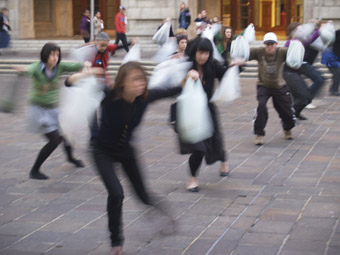a monument of dancing bodies
tank man tango: a tiananmen memorial

FOR HUNDREDS OF PEOPLE AROUND THE WORLD, TANK MAN TANGO: A TIANANMEN MEMORIAL (2009) WAS NOT SIMPLY ART, AN EXHIBIT, BUT A DANCE THEY LEARNED TO MAKE THEIR OWN, TO SHARE AND PERFORM COLLECTIVELY AS PROTEST, OR AS VIGIL, FROM INSTRUCTIONS ON YOUTUBE IN ENGLISH, CANTONESE, GERMAN AND MANDARIN. THE PROJECT GAVE NEW MEANING, DIMENSIONS AND FORM TO THE NOTION OF PUBLIC ART AND THE POSSIBILITIES FOR PROTEST.
Sydney-based artist Deborah Kelly recently won the inaugural James Cook University Screengrab New Media Art Award for Tank Man Tango: A Tiananmen Memorial. It has been shortlisted for the Sadler’s Wells Global Dance Contest, London, to be awarded by popular vote in November. The work featured in Kelly’s solo show at Adelaide’s CACSA (June 12-July 19), at Serial Space’s 649 (June 4-14) and at Screengrab (p23).
Kelly describes Tank Man Tango as “a monument, a memorial, on the 20th anniversary of the Tiananmen Square massacre, built of dancing bodies.” She is very specific about her intentions: “it’s for those who would remember; to give it shape, duration, experience and ritual. Against forced amnesia, it remembers the protests, and the murdered protestors, through that one person, the symbolic tank man. The work pays homage to courage, to fighting tyranny: and god knows, all our governments are bad. It hopes to bring life to history—our lives, and our history. Dancing this memorial is a way to be, to act, in a city or a town, to make a public sphere, to be an agent in it.”
The geographical distribution of the work is impressive. Kelly writes that “[Tank Man Tango] was made on June 4 in Perth, Brisbane, Sydney, Warrnambool, Daylesford, Hobart, Leipzig, Weimar, Bielefeld, Erfurt, Singapore, Mexico City, Melbourne, St Catharines in Ontario, Philadelphia, Auckland, Dunkerque, Belgrade, Athens, Richmond in Virginia, Bristol and in three different parts of Brussels. And maybe other places.”
Kelly had to accept that Tank Man Tango would develop a life of its own in other hands, some with different intentions: “I love that people accepted it as a gift—no, as their right. Many didn’t let me know they were doing it, many didn’t know an artist, or even a person, had made it. Many I have found by sleuthing—some had intentions very different to mine. Some strangers did it somewhere in the US and subtitled it Dancing on the Grave of Maoist Atheism (Jesus!). In Athens, the artists who took it up there seemed to frame it in an understanding that the protestors of Tiananmen Square were demanding capitalism. I realise I undermine my own will for the work by releasing it so freely that people can and have filled it with their own meaning. But that makes it all the more interesting to me; the work’s own disseminated autonomy means I get to understand it newly, over and over.”
If many people made Tank Man Tango by performing it, Kelly also pays tribute to those other makers, the many who helped her realise this unfunded project before it was even danced: Teik-Kim Pok who “taught the steps of the dance Jane McKernan choreographed”, Sumugan Sivanesan who “made the videos in all the languages” and many other contributors who provided space and equipment, translation, dramaturgy, institutional support, live streaming and those who acted as dance leaders. The thank you list reads like credits for a movie, a reminder of the scale of this dispersed, collective project. RT
–
Tank Man Tango, Deborah Kelly, June 4, www.forget2forget.net
RealTime issue #93 Oct-Nov 2009 pg. 2-3






